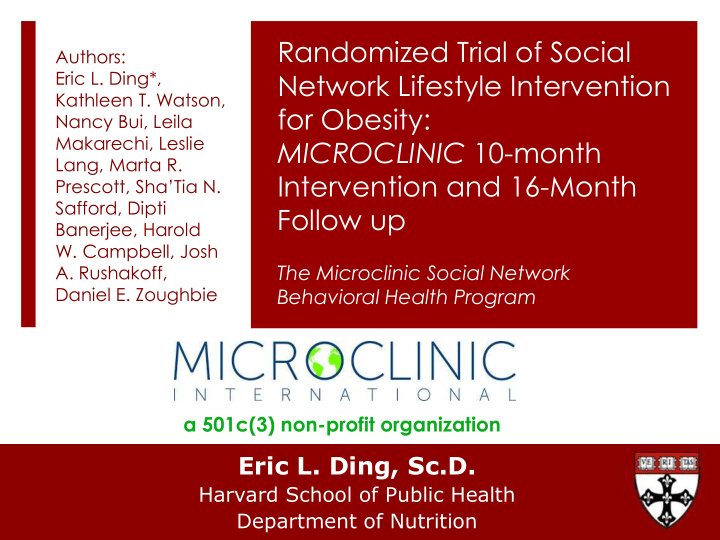



Randomized Trial of Social Authors: Eric L. Ding*, Network Lifestyle Intervention Kathleen T. Watson, for Obesity: Nancy Bui, Leila Makarechi, Leslie MICROCLINIC 10-month Lang, Marta R. Intervention and 16-Month Prescott, Sha’Tia N. Safford, Dipti Follow up Banerjee, Harold W. Campbell, Josh The Microclinic Social Network A. Rushakoff, Daniel E. Zoughbie Behavioral Health Program a 501c(3) non-profit organization Eric L. Ding, Sc.D. Harvard School of Public Health Department of Nutrition
Funding Study conducted by Microclinic International, a 501c(3) non-profit organization. Project supported by grants from Humana, the Mulago Foundation, and the Goldsmith Foundation. E. Ding supported by Scientist Development Grant from American Heart Association (National)
The Potential of Social Networks “ If you wish to go fast, go alone. But if you wish to go far, go together .” (African proverb)
Social networks and health Social network interactions may play a meaningful role in disease prevention. From smoking, to obesity, to alcohol use – such factors are correlated in social networks. Thus, if behaviors may naturally aggregate in social networks, then interventions that leverages social networks, therefore, may hold promise to induce and propagate positive health behaviors
Observational studies of Social Network and Obesity/Smoking
Social Network Paradigm TED. Christakis N.
Types of Social Network Clustering 1. INDUCTION (causation) e.g. A friend/spouse makes/nags the other to goto the gym. Friendship Weight loss 2. HOMOPHILY (selection / reverse causation) e.g. Jane and Jen form a new friendship because both are skinny and gravitate together as friends. Body weight Friendship 3. CONFOUNDING (non-causal correlation) e.g. Sheryl and Susan are a pair of lean friends who met from attending the same high income neighborhood gym. Friendship SES Weight
Limitations of past observational studies on social networks Cannot prove direct causation Cannot disentangle the types of social network clustering Cannot answer if interventions can be PROPAGATED and INDUCED for spreading healthy lifestyles for public health
Microclinic philosophy
MICROCLINIC Program ‘ Microclinics ’ are groups of friends and family members who form together into ‘ microclinic ’ units for participation together in health program. Multiple microclinic units are nested within classes, nested within neighborhood community clusters. The MICROCLINIC program works to: strengthen social interaction foster friends and family within microclinic units to share personal health status information Encourage sharing and propagation of health behaviors within and between microclinic units
Location: Bell County, KY Population= 29,000 • Median per capita annual • income: $11,000 Median household income: • $19,000 Percent below poverty: 31% •
Methods Randomized trial of 9-10 month intervention, followed by 6-7 months follow up at 16 months. Control group received standard health department access and monitoring (in parallel with intervention). Recruited participants to enroll as pre-existing network of friends or family members Multi-level longitudinal random-effects mixed models Hierarchal levels: temporal cohort geographic neighborhood community classroom microclinic individual
Randomization tree INTERVENTION CONTROL Approached for eligibility 1000 4 Excluded- not eligible 125 Excluded- declined 871 Entered Randomization Randomized Allocation 581 290 301 193 Formally Enrolled in Study
Hierarchal Structure of Microclinics within Community
Social Network Layers in this MICROCLINIC trial INTERVENTION CONTROL Community cohorts 5 5 Classes 17 18* Microclinic units 121 93* Participants 297 192 *Among controls, social groups are exist and are identified, but are not activated nor leveraged.
Population Participants 91.5% women 51.5 (13.5) years mean age 36.2 (7.55) mean BMI Overweight or at least 1 metabolic risk factor for eligibility Average microclinic social cluster size: 4.1 participants 494 participants at baseline (80% completed study)
RED color = Open- community program sessions
RED color = Open- community program sessions
Results: Weight (10 + 16 mo) P<0.001 P<0.001
Results: Waist Circumference P<0.001
Results: Systolic Blood Pressure P<0.001 P=0.03
Results: HDL
Results: HbA1c (absolute change)
Results: HbA1c (proportional %) P=0.03
Results: Exercise
Results: Self-Confidence in Health
Summary The Microclinic Social Network Behavioral Health Program lifestyle intervention may be effective for obesity, waist circumference, blood pressure, and glycemic control in resource limited settings. As the first randomized trial designed to harness social network effects, results support the promise of leveraging social networks to propagate health. Results hold promise for socially engineering and designing interventions around social networks to propagate healthy lifestyle in future public health programs.
www.microclinics.org a 501c(3) non-profit organization
Recommend
More recommend